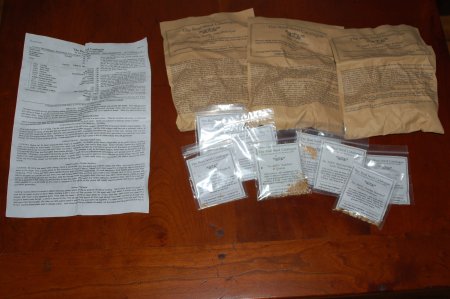This is a question that comes up frequently, and was recently asked by farmgirl_dk in a discussion on Future House. I thought rather than write a very long comment I would make a post about it here.
When you buy a packet of seeds it almost always comes printed with a message saying the seeds are intended for planting in the current gardening year. The question is, can you keep the seeds longer?
In North America seed companies are generally required by law to germination test seeds before they sell them, and the test results are only valid for a few months (about 6 I think). If seeds do not have a minimum germination rate, the seed companies are not allowed to sell them. Once the period of validity for the germination test expires, they either have to be retested or discarded.
What this means is most of the larger seed companies will simply have a large stock of seeds for a particular plant and germination test them each year. Each year if they pass they sell them, otherwise they discard them.
Outside of North America germination testing is not always required. I’ve certainly on more than one occasion purchased a packet of dead seeds here in Amsterdam.
Few seed companies want to admit they are selling very old seeds, so they are generally not labelled with the year they were actually produced. In order to predict how long seeds will last, you really have to have some idea of how old they are.
Since a very important factor in how long seeds last is how well they are stored, and when you buy a packet of seeds you have no idea if it was handled correctly throughout the whole distribution process, it’s very hard to know the condition of seeds when you get them. This is one of the reasons the validity period of the germination test is only a few months, and they are labelled as intended for use within a short period of time.
What I’ve said so far mostly applies to larger seed companies, and seeds purchased through seed catalogs or at garden centers.
If however you purchase seeds directly from a small reputable seed company, like the ones listed on the front page of this blog, they will generally not only label the seeds with the year they were produced but also properly store them up until the time they send them to you. They also don’t usually sell you seeds more than a year or two old. Assuming you store them properly yourself, it is possible to have a good idea of how long these seeds will last. Of course the same thing applies to seeds you have saved yourself.
How Long Are they Good For?
Every plant is a little different, but assuming proper storage, here are some times for common vegetables:
Tomatoes: 5-10 years
Peppers: 3 years
Sweet Corn: 3 years
Other Corn: 5-10 years
Parsnips: 1 year
Cole Plants: 5 years
Carrots: 3 years
Beets and Chard: 6 years
Lettuce: 3 years
Spinach: 5 years
What Happens When They Go Bad?
When seeds get too old their rate of germination decreases, and the chances of them developing into a plant is less.
In general, the only thing that matters for a healthy plant is the DNA contained within the seed. If you have old seed, you manage to get it to germinate and it grows into a plant, there is no reason why that plant should be any less healthy than one grown from a fresh seed.
Your Own Germination Test
If you have some seeds and you want to know if they are still good, one of the best ways to find out is to do your own germination test. To do this, take a few seeds and set them between a few layers of wet paper towel for several days to a week, then count the number of seeds that germinated and compute them as a percentage of the total number of seeds. A germination rate above 50% usually means the seeds are suitable for planting. Less than 50% means you will probably really struggle to get them to grow, and you should get fresh seeds if possible. A germination rate between 50-80% means you should probably sow the seeds closer together in your garden then thin them after they germinate.
Proper Storage
I’ve made a number of posts in the past on the proper way to store seeds, for example here.
In general, proper storage means in a dry place at a steady temperature, in paper or plastic envelopes or bags. The actual temperature in not too critical, but it’s better if it’s on the cool side. You should always protect your seeds from direct sunlight. The bottom of a closet is a good choice.
For longer term storage there are a number of options, like refrigerating or freezing the seeds. For this to be done properly the seeds must be completely dry and stored in a container such as a glass jar with a rubber seal. These storage options always involve some risk, and shouldn’t be used for short term storage. These storage options are rarely useful for purchased seeds with an unknown production date.
Properly freezing seeds will generally extend their shelf life 10 times over unfrozen seeds, so for example tomato seeds up to 100 years, pepper seeds up to 30 years and so on.


